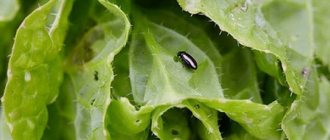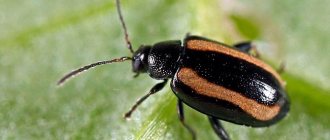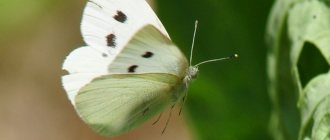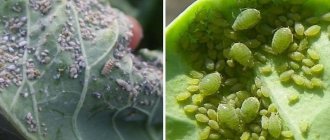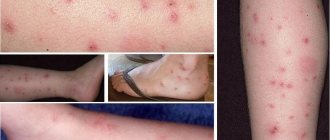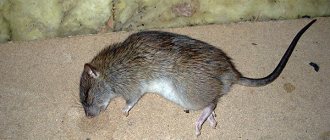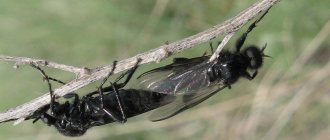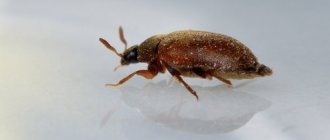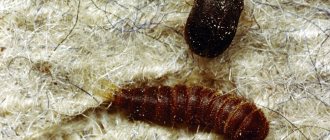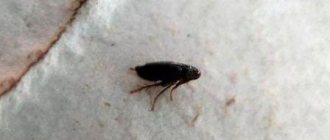1 482
A magnificent, powerful plant, a constant companion of man, suffers from a small pest. How to treat cabbage against flea beetles in order to preserve the harvest was a concern of our distant ancestors. Legends and traditions were written about her. In Ancient Greece, her Day was celebrated several centuries BC. She participated in many rituals and fortune telling. Holidays and folk dances were named after her.
For many peoples, it was a symbol of wealth, love and sobriety, an image of a successful marriage and a symbol of the plurality of worlds. In Russia, proverbs were made about her, she was awarded special signs and rituals. It’s hard to believe that we are talking about ordinary white cabbage, which earned the love of man back in ancient times.
How dangerous is the leaf-eating flea beetle?
“Plant cabbage without walking open-mouthed.” This Russian proverb suggests that growing the usual cabbage has its own subtleties and secrets. In addition to the specifics of planting, you must be prepared to protect the seedlings from bad weather and disease. After all, not only people love cabbage. Its most dangerous pest, the cabbage flea beetle, greatly respects the taste of cabbage.
The cabbage flea beetle, or cruciferous flea beetle, or black flea beetle is a ground flea beetle that belongs to the leaf beetle group. A very small insect measuring about 3 mm is common in Russia, Europe, and Asia. The color of the bugs varies depending on the species:
- black;
- grey;
- blue;
- green.
The adult booger eats the leaves, and the larvae eat the thin roots of plants.
Important! The flea is easy to recognize by its characteristic feature - when disturbed, it begins to actively jump high.
Gardeners have long understood how to treat cabbage against flea beetles in order to save the harvest. As with any disease, many methods of combating this scourge are used.
Insect species
There are several types of beetles. More famous is the light-legged flea beetle, which is wavy, blue and notched. The larvae are small white-yellow. They have three pairs of legs. The larvae live in the ground and eat the roots of cabbage and radishes. But the cruciferous flea beetle itself causes the greatest damage to plants. Beetles lay eggs in the soil. And only the light-footed one leaves its offspring on cabbage leaves. The larvae grow for about a month. Then in the soil they turn into adults, which are capable of destroying plantings in a couple of days.
After their invasion, the plantings have a characteristic appearance. The leaves become lacy. Sometimes only veins remain from plants. Insects can eat not only leaves, but also buds, flowers and pods. As soon as the first signs of insect infestation appear, it is worth starting to fight them immediately. In addition to cabbage, beetles are happy to try turnips, watercress, radishes, and radishes.
Biological characteristics of the pest
In cold weather, the cabbage bug hides under fallen leaves and shallow underground. With the onset of warm days at temperatures above 15 degrees, the adult insect comes to the surface. This leaf-eating pest begins to feed on weed leaves.
In hot and dry weather, the insect reproduces with incredible speed. During the warm season, a flea beetle on cabbage is capable of producing three offspring, infecting the entire garden and destroying seedlings within two to three days. It is especially severe in May. Very quickly, plant leaves become covered with a network of small holes, they weaken and die.
This flying bug jumps very well thanks to the special structure of its hind legs. This behavior is a characteristic feature by which he is easily recognized.
Plants of the cruciferous family are most severely affected by this pest:
- all types of cabbage;
- turnip;
- radish;
- turnip;
- horseradish.
In addition to cruciferous crops, the flea beetle damages roses, chrysanthemums, and gillyflowers.
If a garden plot is infested with a bug, it is necessary to discard cruciferous green manure. For example, from white mustard.
The pest is widespread throughout the country and feeds during warm weather. Therefore, the harvest must be constantly monitored so as not to lose it.
Adult cabbage plants are no longer afraid of losing a few leaves, but seedlings often die completely.
Important! To reduce the likelihood of pest infestation of beds, it is necessary to observe crop rotation and not plant cruciferous crops where they grew last season.
When and how does the pest attack seedlings and adult plants?
Flea beetles are especially rampant in the spring.
They appear in late March - early April, when the air temperature rises to 15°C. At this time, adult beetles lay eggs and begin to nibble young leaves of seedlings, scrape off the skin from them and gnaw through the leaves. Fleas are most active from 10 to 13 in the morning and from 16 to 18 in the evening. Flea larvae are also very dangerous. They feed not on leaves, but on cabbage roots. They devour the thinnest and most tender roots, that is, the very organs of the plant that absorb water and nutrients from the soil. Having lost most of the absorbent roots, cabbage will suffer from a lack of moisture, mineral salts and will slow down in growth.
Flea beetles do not give rest to cabbage even at the beginning of summer, when their new generations arrive. By the beginning of July, their numbers and activity gradually decrease, but they do not completely abandon the cabbage throughout the season.
There is a concept of an economic threshold of harmfulness, that is, the number of pests, starting from which the damage they cause becomes noticeable:
- for seedlings: 3-5 flea beetles per plant when they occupy 10% of the seedlings;
- during the period of leaf whorl formation – 10 pests per bush with a population of 25% or more;
- at the beginning of head formation - when 3-5 beetles sit on one plant, but more than 50% of the bed is affected by them.
Traditional methods of struggle with natural preparations
Flea control is carried out using different methods. Our grandmothers knew how to get rid of cabbage flea beetles. Gardeners strive to use natural remedies:
- Wood ash. You need to scrupulously pollinate cabbage with ash, not forgetting to sprinkle the leaf on all sides. This must be done several times with a break of 3-4 days between pollinations.
- A solution of ash and soap. A good effect is achieved by using not pure ash, but an ash solution with laundry soap, which lasts better and longer on the seedlings. In a 10-liter bucket of water, stir 3 kg of purified ash. The solution is infused for two days, then it is filtered and 40 grams of soap shavings are dissolved in it. The seedlings must be bathed in the solution on all sides. The solution is also used once every 2 weeks until the bug disappears.
- Dry mixture of ash and tobacco dust (1:1). This mixture must be sprinkled on the seedlings and the ground underneath them.
- A mixture of ash and slaked lime (1:1). It is used in the same way as the previous mixture. Enough 2 tbsp. l. per sq. m. area.
- A mixture of ash and black pepper powder (1:1).
- Ground red pepper. You can make your own ground red pepper powder from your hot pepper harvest. It is better to process seedlings after watering.
- Decoction of tomato stems. Add 4 kg of finely chopped tops to a 10-liter bucket and leave overnight. The infusion is boiled together with the tops, cooled and filtered. When using, the solution is diluted with water 1:1, adding 3 tbsp for stickiness. l. planed laundry soap. It can be stored for a year under a tight lid.
- An infusion of garlic, onion, wormwood, dandelion, and potato tops can repel pests from garden plants. It is prepared in the previous way.
- Powder made from dried celandine, coriander, dill, and marigolds can also scare away uninvited guests from the garden beds.
In spring, the insect begins to graze on the weeds growing in the garden. Therefore, keeping the beds clean is also a preventive measure and weeds must be gotten rid of even before planting seedlings. It is especially undesirable to allow the growth of weeds from the cruciferous family such as cress, shepherd's purse, and mustard.
Even watering the planting site with boiling water or watering the cabbage bed with very cold water will help say goodbye to the cruciferous flea beetle.
Treatment of affected plants should be carried out either early in the morning when there is dew, or late in the evening, when insects stop jumping and flying.
The described methods are good when used frequently, when the gardener has the opportunity to treat the beds with natural remedies every three days. If he visits the garden once a week, then folk methods of struggle will not help. In this case, you have to use special pest control products - insecticides.
Cultural information
White cabbage is a favorite garden crop among residents of different countries. The high-yielding vegetable is very healthy. It contains vitamins A, C, P, K, group B, potassium, calcium, phosphorus, etc. Even several months after harvesting, all useful substances are retained in the vegetable. Many people say that cabbage is a natural vitamin complex. Heads of cabbage make delicious dishes and homemade preparations.
The crop is most often grown using seedlings. Small bushes grow at home for 40-60 days. After the seedlings are transplanted into beds under the open sky. Caring for the plant is simple. It is spudded several times a season. Thus, oxygen reaches the roots, as a result they become more resistant to diseases and grow faster.
Cabbage loves fertile soil and fertilizing. During the growing season, the heads of cabbage need to be fed 3 times. After transferring the seedlings to a permanent place, they are flavored with superphosphate, potassium chloride, and ammonium nitrate. At the beginning of the formation of heads of cabbage, another feeding is carried out. The same substances are taken. The third feeding is carried out in the middle of the season. Fertilizers that contain potassium are used. Watering the cabbage bed is organized once every 2-4 days. There should be enough moisture, but the soil should not be flooded.
Watering cabbage
Control with insecticides
The use of these drugs requires mandatory adherence to the rules for the preparation and concentration of the working solution and the specified frequency of use. You cannot deviate from the technology for using the product described in the instructions. It is also necessary to use personal protective equipment: rubber gloves, clothing that covers the body and a protective face mask.
The following drugs give good results:
- "Aktellik". 20 ml of the drug is diluted in a 10-liter bucket of water. It is enough for 100 sq. m., process the plant from all sides.
- “Decis”, “Aktaru”, “Bankol”, “Intavir” are bred in the same proportions.
- “Karate” will have to take a little more - a 10-liter bottle will require 2 ml of product. The inconvenience in using this drug is that it is not the plant that needs to be treated, but the bugs.
In addition to these insecticides, you can purchase other preparations of contact-intestinal action against gnawing insects in garden stores.
Household chemicals used against pests are less potent, but also less dangerous. It effectively gets rid of fleas on cabbage:
- vinegar essence. To treat plants, the essence is stirred in 10 liters. bucket of water, adding 2 tbsp. l., obtaining a 70% solution. Processing is done on dry seedlings;
- shampoo for dogs. Diluted 4 tbsp. l. in 10 liters of water;
- ammonia, 1 tbsp. l. dissolve in 10 l. water, the pungent smell will scare away the bug.
Important! Do not use chemical pest control agents on early varieties of cabbage.
In addition to various substances that repel or make it difficult for fleas to live in beds, you can also use a simple remedy - glue traps. By placing sheets of plywood coated with long-drying glue or thick machine oil on beds with pests, you can cause significant harm to the bug population.
Signs of radish damage and damage from cruciferous flea beetle
Although the cruciferous flea beetle is small in size, it is difficult not to notice its presence in radish plantings. It is expressed in the following characteristics:
- visual detection of insects that jump in different directions at the slightest danger;
- small through holes appear on the leaves;
- then most of the green plate becomes damaged, becomes skeletonized, and gradually dries out;
- Gnawed passages are visible inside the leaf pulp.
It is very easy to understand that a cruciferous flea beetle has appeared on a radish: all the leaves of the plant are riddled with small, shiny bugs jumping between them
The danger of the pest lies in the fact that in a short period of time it can completely destroy young seedlings. Radish sprouts appear early, it is the first to take on the attack of the aggressor, because just when the crop sprouts, cruciferous flea beetles become active after the winter period. The massive spread of the pest poses a danger not only to young seedlings, but also to adult plants: the beetles will eat the leaves and the top layer of skin on the stems, and the larvae will damage the roots of the plant.
Prevention
Every gardener knows that it is better to prevent diseases and pest invasions than to fight them.
Now many are returning to natural farming. His main commandments are: do not dig the ground, do not leave bare soil without mulch, and feed the plants in a timely manner. Experienced gardeners have long noticed that weakened plants that are fighting for life get sick. The strong plant is not affected by diseases and pests.
Important! Compliance with the rules of natural farming leads to the strengthening of plants, which is the prevention of all diseases and protection from any pests.
Activities that will answer the question of how to get rid of a flea infestation are as follows:
- using mulch on cabbage beds. Covering the beds with lutrasil, spunbond or agrospan will block the flea fleas' exit from the ground and reliably protect the plants from the pest. Instead of agrofibre, you can use film paired with drip irrigation. Also, to make it difficult for the bug to come out of the ground, you can fill the beds with a layer of sand at least 1 cm thick;
- water the beds abundantly in hot weather;
- prevent weeds from growing in the beds by using them as mulch;
Early sowing of seedlings, which will have time to grow stronger before the pest emerges from the ground, can also help out.
Mixed plantings of cabbage and garlic, dill, and marigolds will repel insects from the beds.
A wonderful experimental gardener from Kharkov, Anatoly Petrovich Bessarab, suggested using the serum he invented. It is suitable both for feeding plants and for producing organic mulch from compost. The serum does not destroy pests, but extremely strengthens and heals plants, which stop getting sick, are not affected by pests and produce a stunning harvest.
The composition and method of preparation are as follows: in 1 liter. serum dissolve 1 tsp. sour cream. In 1 l. of settled water dissolve 1 tsp. honey Combine both solutions and add water to 10 liters. Add 10 grams of yeast. In a plastic bucket with a lid or can in a dark place, the solution ferments for a week.
In the future, by 10 liters. Take 0.5 liters of water. solution and seedlings are watered in the spring, in the summer - sprayed on the foliage once a week. After applying the serum, the flea beetle will disappear from the beds.
Harvesting and processing of the finished crop
For better preservation of the grown crop, it must be properly removed and processed before storage. It is necessary to harvest cabbage in dry, cool weather. Only varieties with medium and late ripening periods are suitable for long-term storage. Early ripening cabbage should be used as quickly as possible.
To prevent spoilage (cabbage is susceptible to rotting and drying out during storage), treat cut heads with crushed chalk (200 g of chalk per 10 kg of vegetables). Similar treatments should be repeated each time spoiled leaves are removed.
Storing cabbage - what diseases can ruin the harvest? Improper storage of cabbage can lead to dire consequences.
In addition to the above measures, when growing cabbage, do not forget to remove weeds and plant debris in a timely manner, follow the agricultural techniques for growing the vegetable and do not neglect crop rotation.
An integrated approach to the treatment of diseases
To prevent the culture from getting sick, it is recommended to follow certain rules:
- If you are afraid of pests and diseases, then treat the plant in a timely manner and use traditional methods as a preventive measure.
- Provide Chinese cabbage with the necessary conditions, monitor the temperature, water and loosen the soil in a timely manner.
- Don’t forget about fertilizers and “treating” the seeds before planting.
- Make sure that there are no pests in the area; they can easily move from one crop to another.
An integrated approach involves following general rules for caring for vegetables, which helps minimize risks.
How to fight Chinese cabbage
Growing Chinese cabbage is in many ways similar to traditional white cabbage. Tender leaves are a great temptation for insect pests, so vigilance only needs to be increased.
Common pests for Beijing are:
- Aphid.
- Cruciferous flea beetle.
- Cabbage whites.
- Cabbage fly.
- Slugs and snails.
When spraying Chinese cabbage, it is necessary to reduce the concentration of active substances so as not to burn the sensitive leaves. Basically the same methods are used, but the frequency and number of treatments can also be reduced.
Cabbage aphids cause a lot of trouble for gardeners. Juicy cabbage leaves are her favorite delicacy, so the plantings are constantly under attack. If you notice subtle larvae or adult insects on the back of the leaves, you need to act immediately! The main ways to get rid of cabbage aphids on cabbage are discussed in the information in our article.
